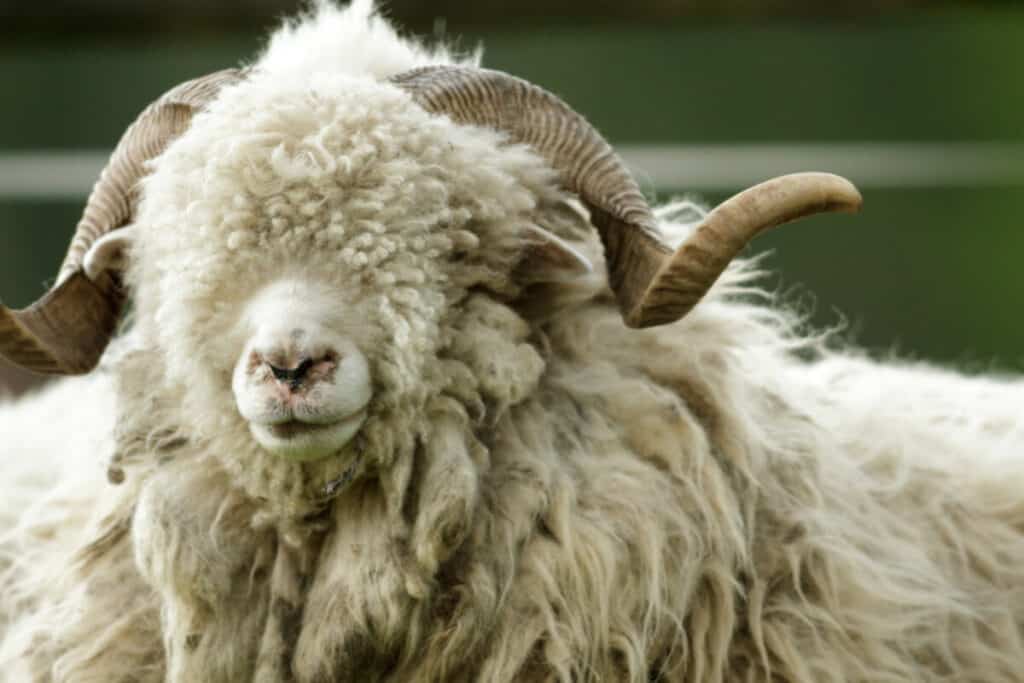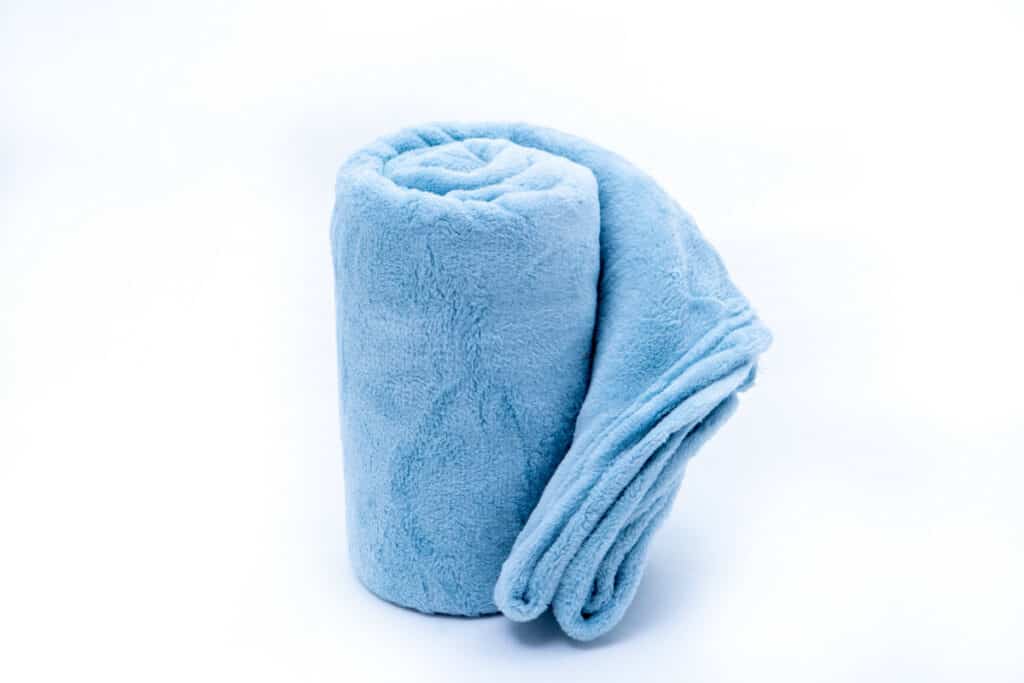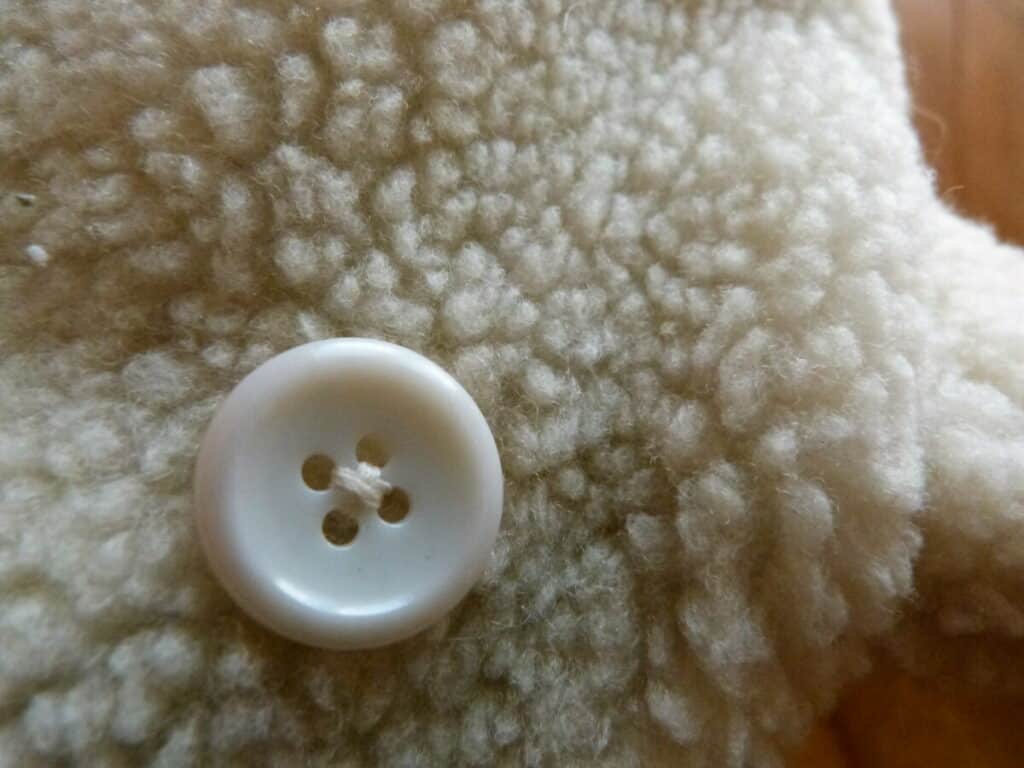There are many people out there who enjoy fleece blankets and outerwear, but what actually is fleece? Is it an organic material or made from something else?
The modern term fleece refers to a fabric specifically brushed during its manufacturing process to raise the fabric fibers to create an insulating layer. Fleece is typically polyester, but it can also be cotton and may or may not include Spandex. Different combinations and processes result in unique types of fleece such as flannel fleece, coral fleece, and sherpa.
Although fleece is a relatively common material, there are many people who may not know exactly where it comes from or what goes into making it. Not only is it important to know what kind of variety fleece offers, but also what effects this material can have on the environment. Carry on for an intriguing deep dive into the details of fleece.
By the way, as an Amazon Associate, I earn when buying qualified products through links on my site.

Is Fleece Always Made From Polyester?
Fleece is most commonly made from polyester, but it doesn’t have to be–some fleeces are made from 100% cotton, and there are many fleeces that blend materials like wool, cotton and spandex, which adapts the resulting material to a wider variety of needs.
Fleece is a type of fabric that has been brushed in a specific way to raise the fibers which increase the softness of the fabric as well as its insulative properties. Brushing fabric makes the fabric retain your body heat much more effectively.
This video has a before and after of brushed French Terry fabric, and you can clearly see what the difference is between a regular fabric and fleece.
Some may be surprised to learn that polyester is plastic. The manufacturing process – as well as the chemicals used in that process – allow that plastic to form into a fluffy material suitable for clothing.
While it’s being manufactured, different chemicals, materials, and strategies can be employed to produce different kinds of fleece. In fact, many companies recycle used plastic drink bottles to spin polyester fibers.
The Term Fleece
Here’s the thing: the term Fleece by itself just refers to a coat. Like the hairy coat of sheep is called its fleece.
In the 1980s, Patagonia marketed the first synthetic fleece (source), and it’s this synthetic fleece that has become the most common type of fleece that we’re familiar with. When someone says “fleece” they’re most often referring to a brushed fabric that’s been made synthetically.
So, just to end the confusion, fleece is not a specific type of material, it just means a type of fabric that has been brushed using special machines to raise the fibers.
What Other Kinds Of Fleece Are There?
Fleece is a popular material, but not necessarily the most understood. Rather than existing as its own material, fleece is made up of a combination of other materials that may include polyester, wool cotton, and even sherpa. The end result provides different benefits depending on the materials used to create it. Below, we’ll take a look at what you can get from different kinds of fleece.
Cotton
An organic material, cotton fleece is often used in our more comfortable clothing items like sweatshirts and pants. Alongside polyester, this material uses cotton in the creation of fleece clothing items. A cotton fleece may retain water more than a synthetic fleece.
However, cotton fleeces do not leach microplastics into the environment as they’re washed.
Knowing the difference between polyester fleece and cotton fleece can really help you to select clothing items that fit your needs. To learn more about the differences between cotton and polyester fleece, take a look at our article on the subject here.
Spandex
Combined with the main fleece fabric (cotton, polyester, wool), spandex adds a touch of elasticity to your outfit. As a result, spandex fleece is ideal for lightweight athletic wear that focuses on warmth without adding bulk—options like the Subuteay thermal work well as a single layer on chilly days. When the temperatures drop, spandex fleece can be used under other layers to keep you comfortable in the cold.
Sherpa
Sherpa fleece is reminiscent of coats from Yaks presumably from the Himalayas.
Sherpa fleece has a different look and texture than regular fleece. While regular fleece has a uniform appearance, Sherpa fleece is made up of different bunched clusters of fabric with a longer pile, as you can see in this picture:
This extra brushing and these extra air pockets can lead to more insulation and therefore a fabric that keeps you warmer. It’s often used as an inner liner to add heat to certain clothing items. Due to its added quality, sherpa fleece is commonly used by well-known brands like Columbia Sportswear. Here’s an example on Amazon.
Sherpa fleece, as far as I can find, is only made from polyester.
Polar
Polar fleece is actually the original name for fleece as we know it today. Polarfleece, developed by Malden Mills was marketed and sold by Patagonia starting in 1981. (source)
So when someone says polar fleece, it’s either one of two things:
- Just a regular fleece but with a “cooler” name (sorry for the pun)
- A company that makes “polar” fleece might use the name to refer to a special technique they use for their fleeces.
For example, I reached out to Columbia Sportswear and asked them how they define a polar fleece, and this is what they had to say:
Polar fleece tends to be a little thicker than regular fleece, therefore, warmer
Columbia Sportswear rep

That’s not really a technical difference–it sounds like a pretty loose definition for Columbia. This means that different manufacturers will call polar fleece something different–you’ll have to ask each brand separately to find out.
Polar fleece is most often made from polyester but you can find cotton polar fleece, like here.
Wool is another material that is often highly recommended for hikers and campers. Learn more about the differences between wool and fleece in our article on the topic here.
Eco-Fleece
Instead of creating plastic specifically for fleece items, Eco-Fleece like the S600 is made from recycled materials. This type of fleece aims to reduce the effects of plastic on the environment by reusing items like plastic bottles.
This is a marketing video from another brand, Decathalon America, which shows a bit of their process:
As a note, even though this helps with reusing plastic materials, fleece still has the microplastic lint problem.
Coral Fleece
Coral fleece is another term that will probably vary from one manufacturer to another. This gentleman shows different types of fleece including coral, flannel and wool fleece. In this example he describes coral fleece as a shorter pile.
Because there is no strict definition of coral fleece, this really depends on who is making it.

Wool Fleece
Wool fleece is a bit easier to spot since it resembles big bunches of fabric making it seem more wooly–it’s still often made from polyester. You can see an example of it in the video I shared earlier.
Understanding Micro, Mid, And Heavyweight Fleece
| Fleece Weight Type | GSM |
| Microfleece | 200GSM or less |
| Mid-Weight Fleece | 200-300GSM |
| Heavyweight Fleece | Over 300GSM |
As you might expect, the weight of any fleece will play a role in how warm it is. Microfleece is the lightest and thinnest, allowing for the best range of movement. However, microfleece provides the least amount of warmth.
Heavyweight fleece is best for colder temperatures. When you need to prioritize staying warm over being able to move easily, this is the best option. Between the two is mid-weight fleece, which balances out warmth and flexibility. Choosing the weight best suited to the weather you’ll be in will help you to stay warm and comfortable outdoors.
Benefits And Downfalls Of Wearing Fleece
Just like any other material, fleece comes with plenty of pros and cons. Ultimately, what that means is that there are situations that are perfect for fleece and situations in which the material should be avoided. Take these benefits and downfalls into consideration when you’re considering fleece for your outdoor activities.
Benefits Of Fleece
Warmth
Fleece is a fantastic material for keeping your body temperature up while you’re out in the cold. Because of it’s brushed design, air pockets infiltrate the fabric which is remarkable for trapping body heat. Because of its superior insulation quality, this material is often used for blankets and outerwear. Fleece jackets are popular because they’re soft, lightweight, and very warm.
In fact, I use my pullover fleece whenever it’s cold outside, I’ve taken this fleece snowboarding and in sub-freezing temperatures many times. It’s my favorite mid-layer coat and it’s super warm.

Freedom Of Movement
We’re all familiar with the feeling of being unable to move efficiently when we’re all bundled up. Especially while hiking, you may not want to wear a puffy jacket for exactly that reason. As long as the weather isn’t too cold, fleece works as an alternative that provides you with warmth without restricting your movement.
You can’t see my fleece in this picture, but I used my fleece as my mid-layer when I was running in very cold temperatures:

Breathable
In addition to warmth, fleece also provides the wearer with breathability. Hiking in the cold can create a unique situation in which you need heat but don’t want stale air to become trapped. The breathability allows for enough airflow to keep your skin dry without letting in the cold. While fleece is still going to be too much in warmer weather, it offers a decent level of versatility at colder temperatures.
For my fleece pullover, it’s fairly thick, and it’s too uncomfortable to wear above 55 degrees Fahrenheit. But if you have a thinner fleece you won’t experience that.
Breathability is essential when it comes to regulating temperature. In the outdoors, we can often have a hard time finding a balance between warmth and dampness due to sweat. Discover just how breathable fleece is in our article here.
Quick-Drying
Fleece isn’t waterproof, but it is a material that can dry quickly. Consequently, you won’t have to worry too much if you end up in the rain during a hike. It is best to avoid letting fleece get soaked, but a little dampness can dry out pretty easily. Make sure to take the thickness into consideration and allow the material to dry completely before using it again.
In fact, we are using fleece as we potty train our son–he uses fleece blankets as the pee just passes through and absorbs into cloth diapers that we are putting underneath his blanket. The fleece still feels dry because it’s a lot of air in the fabric the pee just passes through. Incredible stuff.
Downfalls Of Fleece
May Require More Care
Fleece is undoubtedly an easier choice to care for than many others out there. That said, it can still be prone to issues like pilling or becoming overly fuzzy. In order to prevent these issues, you may need to take special care of your fleece items. Howtosew.org recommends using cold water without fabric softener or bleach. Lint can also be a problem for this material.
Eco-Friendliness
Contrary to other popular materials, fleece isn’t considered to be a particularly eco-friendly material. According to plasticsoupfoundation.org, fleece is guilty of releasing microplastics into the environment when it’s washed. Over time, those microplastics end up in just about everything we consume. There are ways to decrease the number of microplastics your fleece clothing items release, but the only way to stop the release of these microplastics is to avoid using fleece.
Eco-fleece (fleece made from recycled materials) is one alternative for those who want to reduce its effects on the environment.
The other option is to get all cotton fleece–they do exist and they have many of the same warmth benefits with none of the microplastic shedding.
Not Temperature Regulating
While it is great for warmth, fleece is not designed to regulate temperature the way materials like wool can. If the weather warms up while you’re out camping or on a hike, you may end up getting too hot. If you’re going to use fleece as an outer layer, make sure you have cooler layers underneath so that you can easily cool yourself down.
Is 100% Polyester Fleece Soft?
It would be shocking to find any fleece that isn’t soft, but there are different levels of softness that can be expected from the material. Sherpa and flannel fleece have a longer pile and can be less blunt. Overall, it depends on how fine they manufacture the fabric.
What is worth paying attention to is the quality of the fleece. Seek out reliable brands that put a lot of care into their products. The good news is that 100% polyester fleece is often quite affordable.
What Type Of Fleece Is The Softest?
What makes the answer to this question tricky is the fact that fleece is capable of providing different kinds of softness. Some fleece options are very plush while others provide more of a velvety texture. The type of softness you’re looking for really plays a role in what type of fleece you should consider.
Microfleece is a great choice for those who want something soft and thin. This type of fleece is great for providing comfort while the wearer is on the go. If you get a thin microfleece, it doesn’t provide as much warmth as other choices. Sherpa fleeces are thicker and fluffier. For blankets and soft outerwear, these are ideal choices.
Is Fleece Hard To Take Care Of?
Fleece is generally considered to be a durable material. However, the washing requirements will depend on the specific item as well as what materials were used to make the fleece. For example, sherpa fleece may need to be handled differently than standard polyester fleece.
The following steps are essential for washing fleece:
- Check the label. There are general instructions you can use for most fleece, but some items may have special needs. The label will provide any additional instructions required.
- Washing and rinsing. When placing your items in the washing machine, make sure to use a gentle detergent as well as cold water for the best results.
- Dry the fleece. Fleece can be put in the dryer, but you should check the label from fleece to fleece as it depends. If it must be air dried, hang it up in a dry space – ideally with some moving air. Allow the fleece to dry completely before putting it away.
Additional considerations.
- Fleece attracts floating particles like lint and hair, so be careful when deciding which other items to wash it with.
- Some fleece clothing may need to be washed by hand.
- Fleece will hold its shape longer when stored in a drawer rather than on a hanger.
For a more detailed look at washing and caring for fleece, take a look at The Spruce website.

